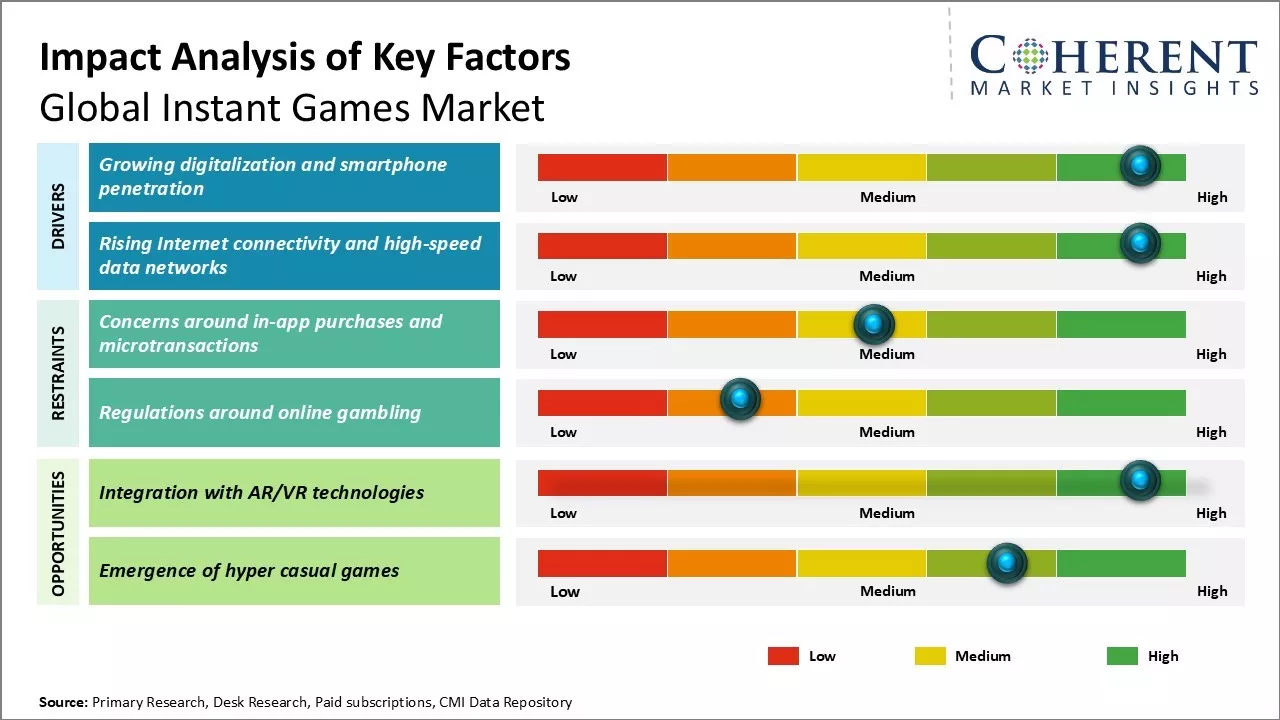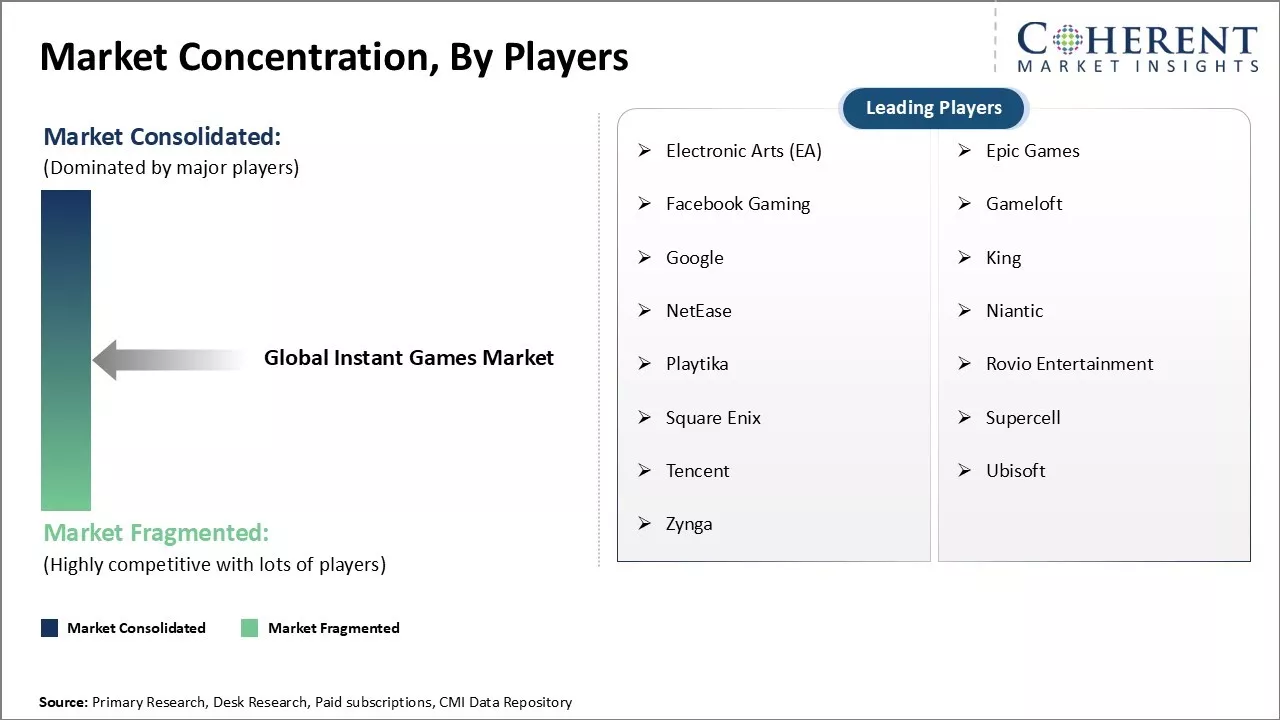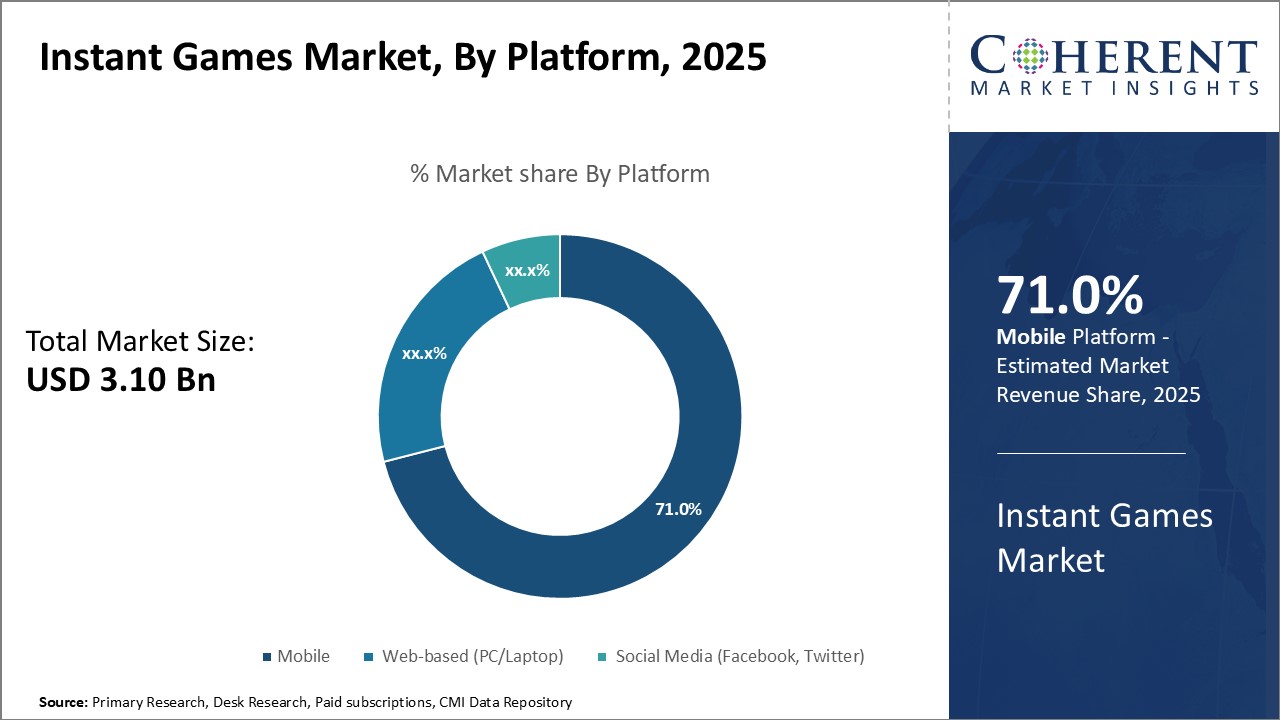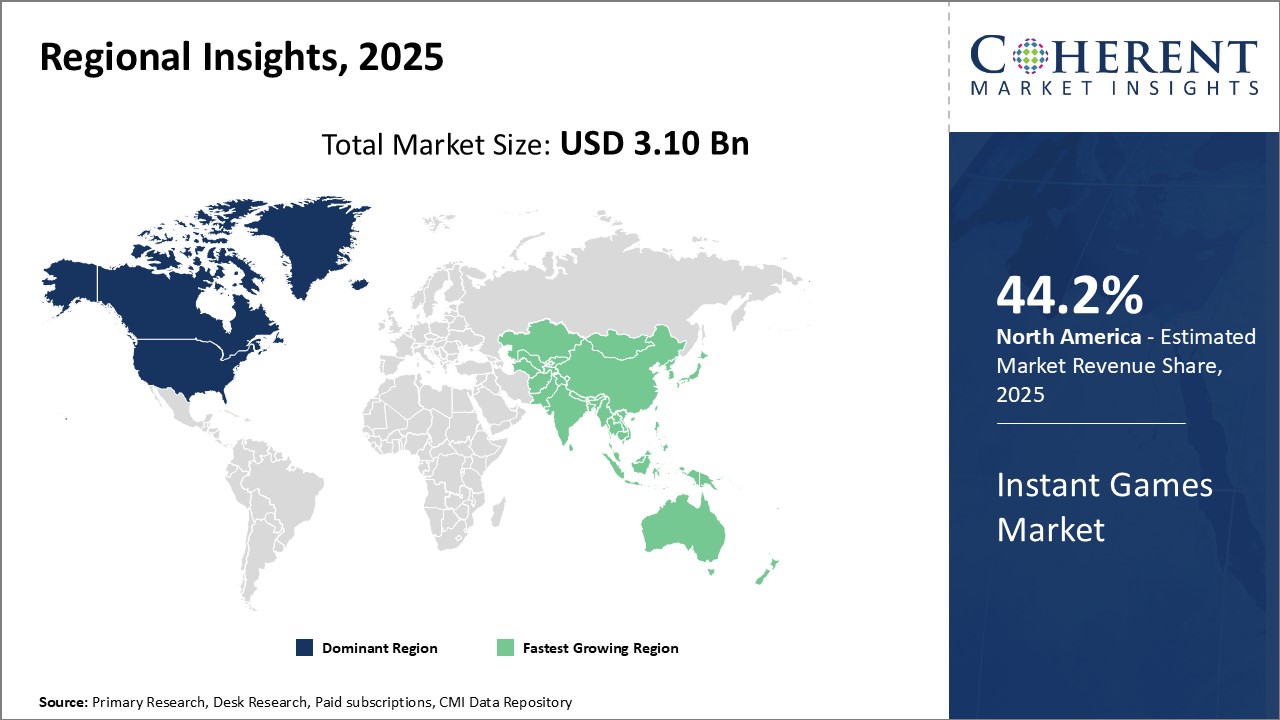Instant Games Market Size and Trends
The Global Instant Games Market is estimated to be valued at US$ 3.10 Bn in 2025 and is expected to reach US$ 7.58 Bn by 2032, exhibiting a compound annual growth rate (CAGR) of 13.6% from 2025 to 2032.

Discover market dynamics shaping the industry: Download Free Sample
The instant games market is witnessing high growth owing to the increasing popularity of casual games among consumers. Social media and online gaming platforms have made instant games easily accessible to a wider audience and their engaging formats are highly shared online, which is driving the market's trend upwards. The availability of instant games on virtual gaming platforms removed limitations of time and location, boosting players' engagement with these short-format games. Introduction of innovative game formats, attractive themes and improvements in gameplay mechanics by manufacturers have also augmented the demand over the years.
Growing digitalization and smartphone penetration
This widespread digital transformation has tremendously benefitted the online gaming industry. The always-connected nature of smartphones combined with their localization and processing capabilities have made them ideal platforms for digital games. Mobile gaming was one of the earliest to move online and has now become the dominant platform for casual as well as hardcore gaming worldwide. The ubiquitous availability of high-speed internet and presence of over 2 billion smartphone users globally have opened up a massive untapped market for online and mobile games. Many millennials and Gen Z consumers now instinctively reach for their phones to enjoy short play sessions to kill time. The convenience of being able to instantly access a wide variety of casual games from any place has driven immense popularity of mobile gaming.
Instant matchmaking capabilities have further elevated the appeal of digital games for on-the-go consumption. Being able to quickly get into a multiplayer game match against a random online opponent without any friction greatly enhances the gameplay experience on mobile. Consumers today demand hyper-personalized and frictionless digital experiences, which has benefitted instant games tremendously.
Market Concentration and Competitive Landscape

Get actionable strategies to beat competition: Download Free Sample
Rising Internet connectivity and high-speed data networks
In parallel with rising digitalization, internet connectivity infrastructure across the world has also vastly improved over last decade. Both developing as well as developed regions have invested heavily in upgrading telecom networks in order to reap socio-economic benefits of digital technologies. Widespread deployment of 4G/LTE networks combined with falling data tariffs have made internet highly accessible and affordable for general population. Proliferation of public WiFi hotspots has further augmented ubiquitous high-speed connectivity on mobile devices.
Advancements in connectivity standards along with hypercompetitive telecom markets have transformed internet into one of the most fundamental utilities today on par with electricity and water supply. While developed economies have near-universal broadband penetration, internet access has grown exponentially even in developing nations.
Reliable and ubiquitous connectivity has allowed new technologies and applications to thrive that demand robust network backbone. Instant games in particular have gained widespread popularity riding on improvement in internet infrastructure. Their multiplayer and high-engagement nature demands consistent high-speed access to ensure lag-free real-time interaction between players distributed worldwide. Today, millions enjoy casual esports titles and other multiplayer games on smartphones without connectivity hurdles during transit or on the move, driving further popularity of the format. Overall, advancement of telecom networks worldwide has lowered the access barriers and boosted engagement for internet-dependent applications like instant games.
Key Takeaways from Analyst:
The global instant games market is poised to witness significant growth over the forecast period driven by the rising penetration of smartphones and high-speed internet connectivity worldwide. Growing urbanization and increasing disposable incomes have also bolstered the adoption of social and casual games amongst younger generations in developing economies.
However, stringent regulations around gambling and lottery games remain a challenge to market growth especially in the North America and Europe region. Constant innovations and introduction of new game formats by key players to keep users engaged for longer duration present an opportunity for sustaining revenue streams.
Real-time cross-platform capabilities allowing users to challenge friends on other devices and integration of advanced technologies like AR & VR holds promise to enhance the user gaming experience going forward. Monetization through in-game purchase of virtual coins, power-ups, and character upgrades is poised to remain a major source of revenues for game developers and publishers.
Market Challenges: Concerns around in-app purchases and microtransactions
One of the major challenges currently seen in the global instant games market is increasing concerns around in-app purchases and microtransactions within mobile games. Over the last couple of years, there have been numerous instances where gamers, especially younger audiences have ended up spending large amounts of money on in-game purchases without realizing it. With laws and regulations on these microtransactions expected to get tighter going forward, it poses a threat to the business models of many companies. They would need to shift to alternative models that are less reliant on recurrent in-app spending in order to comply with new policies. Unless addressed properly through more transparent practices, this issue can negatively impact the revenue growth trajectories of market participants.
Market Opportunities: Integration with AR/VR technologies
A significant opportunity for the global instant games market in the coming years will be deeper integration with augmented reality and virtual reality technologies. As AR/VR headsets become more accessible to consumers and their functionality improves, game developers can leverage these mediums to enhance the gaming experience for certain types of real-time and interactive games. Titles that allow virtual interactions between players or incorporate aspects of the real world into gameplay have strong potential to engage audiences. Leveraging immersive virtual environments can also help instant games stand out in increasingly crowded app store landscapes. If powerful brands are able to effectively harness the interactive capabilities of AR/VR, it can drive new user acquisition and unlock additional monetization channels for sustainable growth of the market.

Discover high revenue pocket segments and roadmap to it: Download Free Sample
Insights By Platform - Portability and Convenience: The Key Drivers of Mobile Gaming
In terms of platform, mobile gaming has emerged as the dominant segment within the global instant games market with an estimated 71.0% share in 2025 owing to the convenience and portability offered by smartphones and tablets. Mobile devices have now become an extension of users' daily lives with constant connectivity being the norm. This has translated into greater opportunity for gaming on the go. Users can easily access games during their commute, waiting periods or other spare moments throughout the day without having to sit in front of a PC or gaming console.
The ubiquitous presence of smartphones has made it possible for users to discover and try out new instant games with minimal effort. Casual and hyper-casual games that can be played in quick sessions are particularly well-suited for the mobile platform. Coupled with seamless syncing across devices, users enjoy a consistent experience regardless of whether they are on their smartphone, tablet or other device. This has boosted stickiness and engagement for mobile games.
Advances in mobile technology have also enhanced the gaming experience. Powerful mobile processors now offer graphics capabilities approaching those of dedicated handheld gaming devices. Larger and brighter screens coupled with other features like gyroscope and touch support make mobile a highly interactive and immersive gaming interface. 5G networks are further optimizing load times and gameplay. These technological upgrades are expanding the mobile platform's appeal beyond casual games into more complex genres.
Overall, the inherent advantages of mobility and constant connectivity have made smartphones and tablets the default devices for sampling instant games. This strong first-party access leads to greater monetization potential through in-app purchases and other means, cementing mobile's leadership position within the global instant games segment.
Insights By monetization model - Free-to-Play Model: Removing Friction for Discovery and Engagement
In terms of monetization model, the free-to-play (F2P) segment has become the dominant approach globally with an estimated 61.7% share in 2025 owing to its success in reducing barriers to entry. With F2P games, users can download and sample titles at zero upfront cost, facing no risk of wasting money if a game turns out to be unappealing. This has maximized opportunities for sampling and word-of-mouth promotion.
F2P also helps retain players by spacing out new content unlockable over longer play sessions. Rather than tiring of a paid title quickly after a one-time purchase, F2P games incentivize returning daily or weekly through new quests, levels, challenges etc. This drip-feeding of entertainment keeps users engaged in the free version for far longer than conventional paid games.
Monetization happens subsequently based on optional in-app purchases that enhance gameplay convenience or unlock premium features. Since payment happens post-trial rather than pre-trial, users feel less reluctance in spending within games they are already invested in. This has boosted average revenue per paying user for F2P titles. Given the model's proven ability to convert free users into paying customers gradually, its share of the global instant games market has grown steadily.
By removing financial commitment barriers, F2P has emerged the most effective monetization approach for sampling-driven instant games. It maximizes the initial opportunity for viral and word-of-mouth growth before monetizing through in-game engagement over longer usage lifecycles. This virtuous cycle has cemented F2P's leadership position within the global instant games segment.
Insights By end user - Casual Convenience Fuels Individual Gamers' Dominance
Within the end user segment, individual/casual gamers segment is estimated to account for 49.4% share of the global instant games market in 2025. These individuals play games largely as a casual pastime rather than an immersive hobby. Their preference for convenience and flexibility over complex gameplay has boosted the popularity of instant games perfectly suited to their needs.
Instant games have low barriers to entry, with most titles being completely free and taking just a few minutes to understand controls and objectives. This makes them ideal for playing spontaneously during pockets of spare time throughout the day, whether commuting or at home between chores. Complex multi-hour titles are less compatible with such a casual approach.
Additionally, instant games offer bite-sized entertainment that leaves players satisfied even after short play sessions. Their pick-up-and-play design means gamers can seamlessly resume from wherever they left off when time permits. This ensures optimal use of fragmented spare moments without needing to invest prolonged sessions.
Individual gamers also appreciate instant games' freedom from recurring subscription fees or consistent online connection requirements. They present a flexible gaming alternative to the ongoing commitment demanded by MMOs or multiplayer titles. As a result, the format has resonated most with casual players seeking entertainment optimized for their available time windows and preferences around commitment-free gameplay. Their high numbers have cemented individual gamers' dominance within the end user segment.
Regional Insights

Need a Different Region or Segment? Download Free Sample
North America has established itself as the dominant region in the global instant games market with an estimated 44.2% share in 2025. The large presence of industry leaders in the U.S., such as Scientific Games and Pollard Banknote has enabled them to gain significant expertise in the gaming industry over the years. Their innovative product offerings catering to player preferences along with successful marketing campaigns have helped them capture major market share across the region. Furthermore, the per capita spending on lotteries and instant games is higher in the U.S. compared to other regions. This affluent customer base combined with availability of games at retail stores and online platforms has worked in favor of industry players.
However, the Asia Pacific region excl. Japan is exhibiting high growth and emerging as the new hotspot for instant games market. Countries like China, India and South East Asian nations are posting strong increases in sales of instant lottery and scratch cards. Evolving consumer behavior and rising disposable incomes have made instant games more popular among the youth population here. The market is still fragmented with fewer organized players compared to developed markets. But with growing urbanization and digitization, more local manufacturers as well as international names are entering this untapped market. This will attract investments that are critical for further developing the instant gaming infrastructure and retail network. Early adoption of mobile platforms also provides immense opportunities to engage new customers. If the current momentum sustains, Asia Pacific will challenge the supremacy of other regions in the coming years.
Market Report Scope
Instant Games Market Report Coverage
| Report Coverage | Details | ||
|---|---|---|---|
| Base Year: | 2024 | Market Size in 2025: | USD 3.10 Bn |
| Historical Data for: | 2020 To 2024 | Forecast Period: | 2025 To 2032 |
| Forecast Period 2025 to 2032 CAGR: | 13.6% | 2032 Value Projection: | USD 7.58 Bn |
| Geographies covered: |
|
||
| Segments covered: |
|
||
| Companies covered: |
Electronic Arts (EA), Epic Games, Facebook Gaming, Gameloft, Google, King, NetEase, Niantic, Playtika, Rovio Entertainment, Square Enix, Supercell, Tencent, Ubisoft, and Zynga |
||
| Growth Drivers: |
|
||
| Restraints & Challenges: |
|
||
Uncover macros and micros vetted on 75+ parameters: Get instant access to report
Instant Games Industry News
- In June 2024, the Michigan Lottery Commission, responsible for overseeing the state’s lottery operations, announced the launch of a new instant game titled Bonus Star Millions. According to the press release, this game introduces "a new way to win with an all-new play style" for players.
- In November 2023, Meta, the parent company of Facebook, unveiled a new distribution model for Instant Games (IG). This model enables developers to publish their games directly to Facebook users, even during the early stages of development.
- In August 2021, Razer, a leading global lifestyle brand for gamers, unveiled Cortex Instant Games Tournaments, a new platform designed for instantly playable casual games. Available now for Android devices and soon to launch on Razer Cortex for PC, Instant Games can be played directly within the Razer Cortex app without requiring additional downloads. Hosted tournaments feature tiered Razer Silver prizes, which can be redeemed for a range of Razer hardware, accessories, and digital rewards.
- In July 2021, gaming developer PLAYLINKS announced the official launch of 'Bubble Tumble' on Facebook Instant Games. 'Bubble Tumble' is a bubble shooter game where players help the adorable mouse firefighter 'Coco' clear stages to restore a village enveloped in bubbles. The game features simple controls for earning points.
*Definition: The Global Instant Games Market refers to the worldwide market for games that can be instantly accessed and played on various digital devices without any lengthy installation or downloads required. It includes instant games that can be played on social media platforms, mobile apps, and websites. Popular instant game categories are casual, arcade, puzzle, card, and sports games that allow quick bursts of play anytime, anywhere.
Market Segmentation
- By Platform Insights (Revenue, US$ Bn, 2020 - 2032)
-
- Mobile (Smartphones and Tablets)
- Web-based (PC/Laptop)
- Social Media (Facebook, Twitter, etc.)
- By Monetization Model Insights (Revenue, US$ Bn, 2020 - 2032)
- Free-to-Play (F2P)
- Pay-to-Play (P2P)
- Advertising-based
- By End User Insights (Revenue, US$ Bn, 2020 - 2032)
- Individual/Casual Gamers
- Hardcore Gamers
- Children and Teenagers
- Adults
- By Regional Insights (Revenue, US$ Bn, 2020 - 2032)
- North America
- U.S.
- Canada
- Latin America
- Brazil
- Argentina
- Mexico
- Rest of Latin America
- Europe
- Germany
- U.K.
- Spain
- France
- Italy
- Russia
- Rest of Europe
- Asia Pacific
- China
- India
- Japan
- Australia
- South Korea
- ASEAN
- Rest of Asia Pacific
- Middle East
- GCC Countries
- Israel
- Rest of Middle East
- Africa
- South Africa
- North Africa
- Central Africa
- North America
- Key Players Insights
- Electronic Arts (EA)
- Epic Games
- Facebook Gaming
- Gameloft
- King
- NetEase
- Niantic
- Playtika
- Rovio Entertainment
- Square Enix
- Supercell
- Tencent
- Ubisoft
- Zynga
Share
Share
About Author
Ankur Rai is a Research Consultant with over 5 years of experience in handling consulting and syndicated reports across diverse sectors. He manages consulting and market research projects centered on go-to-market strategy, opportunity analysis, competitive landscape, and market size estimation and forecasting. He also advises clients on identifying and targeting absolute opportunities to penetrate untapped markets.
Missing comfort of reading report in your local language? Find your preferred language :
Transform your Strategy with Exclusive Trending Reports :
Frequently Asked Questions
EXISTING CLIENTELE
Joining thousands of companies around the world committed to making the Excellent Business Solutions.
View All Our Clients
